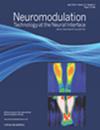Ultra-High Frequency Spinal Nerve Neuromodulation for Improving Bladder Continence: Implications for Overactive Bladder Management
IF 3.5
3区 医学
Q2 CLINICAL NEUROLOGY
引用次数: 0
Abstract
Objective
Ultrahigh frequencies (UHF) have been shown to selectively suppress the sensory pathway with a rapid onset and prolonged effect compared with low frequencies. Few studies have explored the feasibility of UHF electrical stimulation in treating overactive bladder. This study aimed to investigate whether bladder overactivity could be inhibited by UHF stimulation at the L6 nerve root.
Materials and Methods
Female Sprague-Dawley rats (n = 12) were divided into two groups: sham and UHF groups. Bladder overactivity was induced by continuous intravesical infusion of 0.5% acetic acid (AA). UHF L6 nerve root stimulation (500 kHz, 20 mA for 5 minutes) was applied to the rats in the UHF group. To investigate the effects of the treatment, intravesical pressure was recorded by cystometrography during continuous transvesical infusion, with volume threshold (VT) and intercontraction interval (ICI) used to conduct the investigation.
Results
Bladder overactivity was successfully developed in all rats with a significant decrease of median VT and ICI to 83.7% and 86.4%, respectively. UHF stimulation of the L6 nerve root was able to counteract the AA effect by significantly increasing median VT and ICI to 220% and 36.1%, respectively; these effects persisted for ≥two hours. There was a significant difference in the effects of UHF electrical stimulation between the sham and UHF groups (p < 0.05).
Conclusion
This preliminary study provides evidence for UHF stimulation of the L6 spinal nerve root, analogous to the sacral nerve root in humans, as a potential alternative neuromodulation technique to suppress bladder overactivity.
超高频脊神经神经调控改善膀胱持续状态:膀胱过度活动症治疗的意义》。
目的:与低频相比,超高频(UHF)可选择性地抑制感觉通路,起效迅速,作用时间长。很少有研究探讨超高频电刺激治疗膀胱过度活动症的可行性。本研究旨在探讨超高频刺激 L6 神经根是否能抑制膀胱过度活动:雌性 Sprague-Dawley 大鼠(n = 12)分为两组:假组和超高频组。通过持续静脉注射 0.5% 乙酸(AA)诱导膀胱过度活动。超高频组大鼠接受超高频 L6 神经根刺激(500 kHz,20 mA,5 分钟)。为了研究治疗效果,在持续经膀胱输液过程中使用膀胱造影术记录膀胱内压,并使用容量阈值(VT)和收缩间期(ICI)进行研究:结果:所有大鼠均成功出现膀胱过度活动,中位 VT 和 ICI 分别显著下降至 83.7% 和 86.4%。对 L6 神经根的超高频刺激能够抵消 AA 效应,使中位 VT 和 ICI 分别显著增加至 220% 和 36.1%;这些效应持续了≥两小时。超高频电刺激的效果在假组和超高频组之间存在明显差异(P < 0.05):这项初步研究为超高频刺激L6脊神经根(类似于人类的骶神经根)作为抑制膀胱过度活动的潜在替代神经调节技术提供了证据。
本文章由计算机程序翻译,如有差异,请以英文原文为准。
求助全文
约1分钟内获得全文
求助全文
来源期刊

Neuromodulation
医学-临床神经学
CiteScore
6.40
自引率
3.60%
发文量
978
审稿时长
54 days
期刊介绍:
Neuromodulation: Technology at the Neural Interface is the preeminent journal in the area of neuromodulation, providing our readership with the state of the art clinical, translational, and basic science research in the field. For clinicians, engineers, scientists and members of the biotechnology industry alike, Neuromodulation provides timely and rigorously peer-reviewed articles on the technology, science, and clinical application of devices that interface with the nervous system to treat disease and improve function.
 求助内容:
求助内容: 应助结果提醒方式:
应助结果提醒方式:


